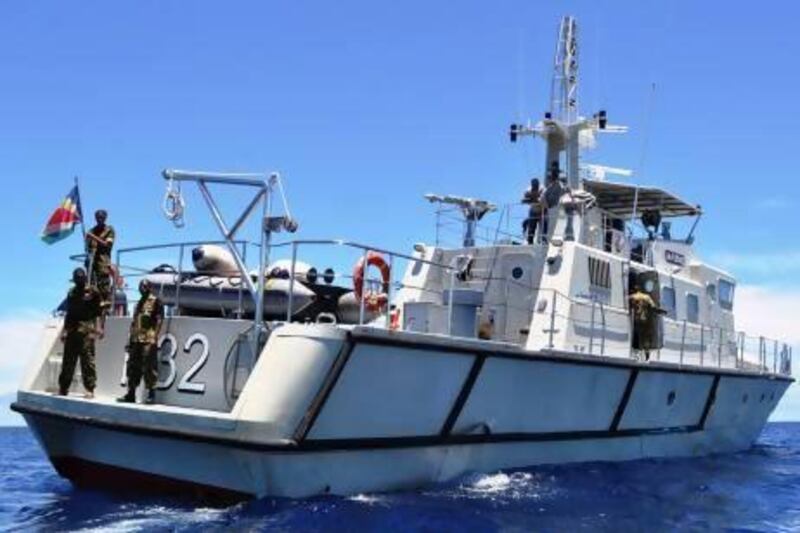If there is a single moment when the Seychelles lost its reputation among pirates as a soft target, it would be in April of last year, when a group of six Somalis armed with AK-47s and rocket-propelled grenades (RPGs) tried to fight off a UAE-supplied Seychelles Coast Guard patrol boat.
By the time the skirmish ended, one pirate was dead, five others were in custody and the four Seychellois hostages they had been using as human shields were free.
But more than that, it effectively marked the end of the surge of pirate attacks that began in 2009 and to which the two mainstays of the Seychelles economy - tourism and fishing - were particularly vulnerable.
For Lt Col Georges Adeline, the acting commanding officer of the Seychelles Coast Guard, a significant factor in that lower frequency of pirate attacks was the response of the international community to the island nation's request for help.
"When the scourge of piracy started, our government sought help from foreign governments. This appeal went across the world," he said.
"The UAE government was the first country that responded. They doubled our capacity."
The National visited Lt Col Adeline in the brand-new Coast Guard headquarters, which was funded with a Dh55 million donation from the UAE.
The dock next door is home to the Coast Guard fleet, half of which - two 30-metre patrol boats and three fast-response craft - were provided by the Emirates.
A network of radar stations on the outer islands to provide early warning of suspected pirate vessels and a long-range surveillance aircraft are also gifts from the UAE.
Other nations and groups such as the EU and UN have also assisted generously. Britain, for example, set up an anti-piracy intelligence centre in the Seychelles and provided assistance in prosecuting and imprisoning the pirates. But none of them improved the capacity to defend and defeat piracy on the front line like the UAE.
This level of vigilance had been unwarranted four years ago, when the pirates' predations were restricted to within 400 kilometres of the Somalian coastline and illegal fishing was the primary threat to the Seychelles' national security.
But now piracy is an undercurrent pervading Seychelles life.
In the nation's main commercial harbour, Port Victoria, some cargo ships bear massive banners warning of armed guards on board, while others feature a series of mannequins clad in wet-weather gear and strapped to the railings to make it seem the crew is on alert for raiders.
Fishermen check the latest piracy alerts alongside the weather forecast before heading out to sea, and usually stay in port if a warning is issued.
The Seychelles People's Defence Force has set up a unit that puts armed soldiers on board pleasure craft that cruise more than 100km from the capital, although the cost is US$300 (Dh1,100) per soldier, per day.
None of this was envisaged four years ago when the authorities only discovered pirates were able to reach Seychelles waters when two Seychellois were abducted and turned up in Somalia, Lt Col Adeline said.
"These pirates came right into our zone and they surprised us because we didn't expect them to feature so far away from their coast," he added.
"The thing is, they hijacked another vessel, which they use as their mother ship. They go from where they hijacked the vessel into our zone and they captured one of our local fishing vessels
"When we realised that particular thing was happening, these people were already sitting in Somalia."
What had changed was that the pirates, facing heavy international navy enforcement of the shipping lanes off the coast of east Africa, started using captured trawlers as mother ships for their attack skiffs, increasing their range to 2,000km from shore and into areas with few patrols.
That range included most of the Seychelles. Within a year of the first pirate raid in Seychelles, 10 boats had been hijacked.
The abduction emphasised the Herculean task the Seychelles faced in securing its own territory, with 87,000 residents responsible for an exclusive economic zone more than twice the size of France.
And it also showed that the Seychellois economy is particularly vulnerable to piracy. The Seychelles is promoted as a trouble-free paradise but, after the emergence of the pirates, tourism revenues dropped by €8 million (Dh38m). Many cruise liners stopped visiting the area.
Fisheries revenue also dropped, by €4m. International fishing boats began going elsewhere, leading to a shortage of tuna supplied to the local canning factory, with production reduced by 30 per cent, at the cost of local jobs.
While the Seychelles government appealed for international help to combat the pirates in its territory, its military was ordered to ensure no more abducted Seychellois would be taken to Somalia.
That resolve was tested in March 2010, when the crew of the fishing boat Galate, with six Seychellois on board, triggered an alarm that they were being raided by pirates.
Major Simon Laurencine, the commander of the Coast Guard patrol boat Topaz, said they set off in pursuit and had the backing of the government to do whatever it took to prevent the pirates reaching Somalia.
"They were making their way towards Somalia but they ran out of fuel," he said. "It was unfortunate that an Iranian fishing dhow was there and they captured the dhow with 21 Iranian fishermen on board.
"Of course, I won't talk about details of operations, but if you want a vessel to stop, you ask the vessel by radio and you show some internationally coded flags [saying to stop so they can be boarded]. We had no alternative but to use force to stop them. First we do a warning shot across the bow to let them know we mean business.
"You never just ask once for them to stop. After three rounds, after maybe half an hour, then from there you use disabling fire and try to disable the vessel. You try to break the engine and then they'll definitely stop.
"They were firing at us - they're desperate people, of course - and we knew they had RPGs and AK-47s.
"When we used disabling fire, the vessel caught fire and everyone jumped overboard. We rescued them and put the pirates in handcuffs."
The nine pirates were put on trial and, in December 2010, each was sentenced to 22 years jail, then the longest jail term ever imposed by Seychelles courts for piracy.
Less than a month later, the UAE fulfilled the promised doubling of the Seychelles Coast Guard's fleet, with the delivery of two 30m patrol boats, named La Fleche and Le Vigilant, and three fast-response craft.
By April, La Fleche was called in when the crew of another Seychelles-flagged fishing boat, the Gloria, raised the alarm that they had been hijacked by seven pirates and were being taken to Somalia.
La Fleche's captain, Tom Estico, caught up with the hijacked boat at dusk and radioed the captain, Francois Souffe, who was told by the pirates to tell the patrol boat to leave.
Souffe spoke in Kreol, the French-based language used in the Seychelles, to say how many pirates were on board and where the crew were sitting. They shadowed the Gloria overnight until another Seychelles Coast Guard patrol boat, the Andromache, caught up.
La Fleche fired warning shots in the air and then across the bow of the Gloria.
The pirates responded by using the crew as human shields as they fired at La Fleche with AK-47s. La Fleche remained 750 metres away from the Gloria and outside the effective range of the pirates. Return fire injured three of the pirates and one of the crew, at which point they surrendered and were boarded by four special forces soldiers from La Fleche.
The injured pirates and the crew member were taken to La Fleche and rushed to Victoria, with one of the pirates dying on the way.
In the Supreme Court of the Seychelles, the judge Duncan Gaswaga said it was the nation's most serious piracy case and imposed 24 years jail on each of the six surviving pirates, bringing to more than 50 the number of Somali pirates serving jail terms in the Seychelles.
Lt Col Adeline said since then, the presence of pirates has continued in Seychelles waters but at a much lower level. Informal feedback via third parties suggest that events like the liberation of the Gloria mean the pirates no longer see the Seychelles as an easy target and now go elsewhere.
But he noted that such front-line battles with pirates in situations such as the hijacking of the Gloria are just a small part of the solution.
"The main thing is to prosecute the pirates on concrete evidence, to make sure they're not fishermen and they're pirates," he said.
"To be sure of that, you have to catch them red-handed, with arms. You have to have the smoking gun. But the pirates, they are very aware of that. Once they see a military vessel and if they know they won't be able to resist, they'll literally starting throwing illegal items overboard.
"The only way to catch them nowadays is through our aerial patrols, which they aren't able to detect but which have very powerful cameras which can zoom onto the vessel and take photographs or record video that can be used to identify the people on board."
The Seychelles' Canadian-built deHavilland Twin Otter surveillance aircraft, another donation from the UAE but given in 2007 for fisheries protection rather than for piracy, provides evidence that can be used to convict pirates in court.
Maj Michael Pouponneau, the commanding officer of the Seychelles Air Force, said the plane had been adapted for long-range use and the cameras on board were able to provide compelling evidence while still remaining outside the range of the pirates' weapons.
"The camera is so powerful, it will see the pirates and it will see the arms they are carrying, RPGs or AK-47s," he said.
"We've heard from other sources, particularly other fishermen in Madagascar, the pirates have said the Seychelles isn't the best place to go to for piracy activities.
"This year we haven't had requests [for help] like we have had in the past. It's maybe 50 per cent."
Lt Col Adeline said there will always be some pirates which find a way into Seychelles territory. But enforcement was only one part of the nation's anti-piracy efforts and there was also an emphasis on averting potential pirates taking up arms in the first place.
"Our message to the pirates is we're not here to destroy them. We're here just to stop them from conducting illegal activities at sea. Especially if they're in our zone," he said.
"The Seychelles has been on the front line for trying - not to eradicate pirates at sea - but we're trying to help the Somalian people to have a better life and trying to help the government, and particularly the law and order in Somalia.
"Because eradicating the pirates at sea isn't the real solution. The real solution is to try to find the source of the problem.
"It's like a river which flows into the sea. You can't stop the flow of the river where it reaches the sea. If you want to stop it, you have to do something at the source and this is what we're trying to do.
"We're helping the [Somali] government, and especially law and order, so economic activities can restart in Somalia. As it restarts, there will be less illegal activity such as piracy at sea."
jhenzell@thenational.ae










